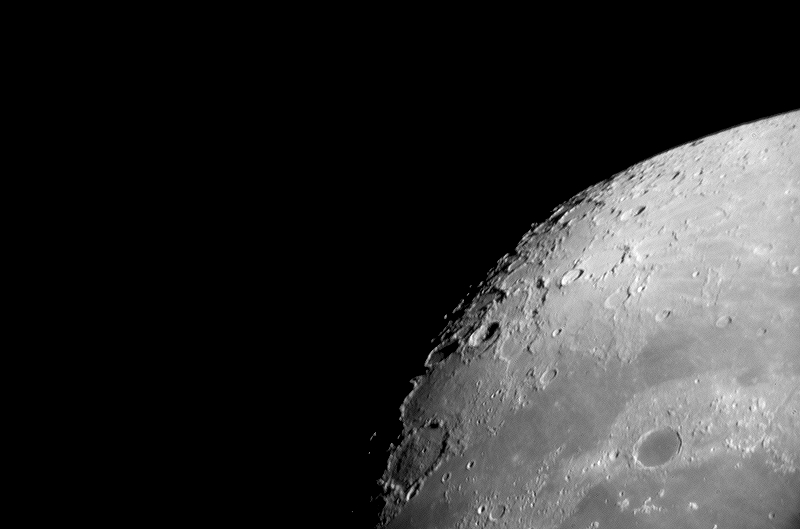
Lunar Crater Philolaus, Saturn with D7000 DSLR
Posted: 22 April 2013
Another pack rat was trapped overnight. It was released miles away from here. That makes three live pack rats and one dead pack rat in one week. Making progress.
The observatory was opened on Sunday, 21 April 2013, at 1817 MST, 91°F. The sky was mostly clear, with some clouds low along the western horizon. At 1827 MST, 30 minutes before sunset, took this photo (full-frame) of the moon with the D7000 DSLR, f/5.6, 1/160sec, 300mm, ISO 100:

At 1835 MST, began doing some lunar observing, first with the 2" 24mm UWA eyepiece (83X) and then with the 2" 9mm 100° eyepiece (222X). Crater Philolaus looked interesting, so I planned to do some high magnification imaging of it later in the night. Seeing was currently not very good though. At 1913 MST, viewed Jupiter and four moons, 222X. Then went back to the moon. Seeing was a little better now.
Mounted the D7000 DSLR at prime focus + focal reducer and at 1923 MST, captured this (slightly cropped) image of the moon, 1/250sec, ISO 100:

This (full-frame) image, prime focus + 3X TeleXtender, "Hat Trick", ISO 100, shows the northern region along the terminator with the crater Philolaus:

I switched to using eyepiece projection with a 1.25" 9mm eyepiece (222X) and captured this (full-frame) image of Philolaus, "Hat Trick", ISO 640:

The crater left of Philolaus showing a nice shadow across the crater floor is Anaximenes.
I resumed lunar observing at 1952 MST, 222X. The black widow spider, first seen a week ago, made another appearance:

She doesn't seem interested in the spider trap I set up.
I continued monitoring the shadows across the floor of crater Anaximenes, 222X. The view was fascinating. By the way, I use two aids to help identify lunar craters: the iOS app "Moon Globe" and the Firefly Moon Map. I grabbed these two images using the iPhone 4, handheld over the 2" 9mm eyepiece:


At 2130 MST, Saturn had risen above the tree to the southeast and I was now able to observe it in the 8" LX200-ACF, 222X. The moons Titan, Rhea, Dione, Tethys, and Iapetus were visible. Switched to the 2" 24mm eyepiece (83X) and tried to see Enceladus, but no luck this night.
I mounted the D7000 DSLR on the 8" telescope for eyepiece projection (222X) imaging. Did a focus test on the star Spica using the Bahtinov Mask. I then did a series of HD video recordings at 1/30sec with various ISO settings. The best recording was at ISO 6400. This is a stack of 1049 frames:

I also tried imaging Saturn at 444X, but the video recordings were too underexposed to be usable.
I completed imaging at 2221 MST and took a final look at Saturn, 83X.
Closed the observatory at 2241 MST, 63°F.
Comments are welcome; use the Comments section below, or you can Email Me. Thanks.
Cassiopeia Observatory Home Page